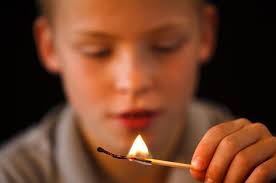Module 3 - Arson and Explosives
Lesson 1- Combustion and Arson
Profile of an Arsonist
![]()
More than 90% of arsons are committed by males, the majority of which are under the age of 18. Usually those arsonists who are under 18 have also been charged with property offences in the past. Those few females who have committed arson are most often motivated by revenge. Adult male arsonists tend to be under the age of 35 and their motive for arson is often for revenge or for profit.
A great number of male arsonists tend to have interpersonal problems with females. They tend to exhibit a lack of remorse especially when they are setting a fire often because of their dissociative trance-like states.
Most arsonists are from lower to working class families. Arsonists who have a middle class background tend to commit arson for vandalism or excitement. Often arsonists have absentee or abusive fathers and a history of emotional difficulties with their families.
About 90% of arsonists have only a high school education or less. The majority of arsonists have IQs slightly below average; 22% are considered to be developmentally delayed. In school, arsonists usually have had learning problems and often were held back a grade—usually in grades 6, 7, 8, or 10.
Arsonists that set a fire for excitement, vandalism, or profit tend to be unemployed. Those that are employed tend to be in subservient positions that they resent.
Young Arsonists
Most of these young arsonists (juvenile males under the age of 18) begin exhibiting interest in fire between 3 and  10 years of age. Motives for young arsonists include boredom, curiosity about fire, accidents, peer pressure, or expressions of anger and stress. A fire deliberately set by a young child usually considered an accident or a result of misbehaviour instead of arson. Depending on the motivation behind the fire setting, how the child is disciplined and/or counselled can have a profound impact on whether or not that child continues to set fires as a teenager or adult.
10 years of age. Motives for young arsonists include boredom, curiosity about fire, accidents, peer pressure, or expressions of anger and stress. A fire deliberately set by a young child usually considered an accident or a result of misbehaviour instead of arson. Depending on the motivation behind the fire setting, how the child is disciplined and/or counselled can have a profound impact on whether or not that child continues to set fires as a teenager or adult.
Fires set by children are usually located in or near the family home. If a child arsonist extinguishes the fire before it gets out of control they often will feel remorse for their actions and try to conceal any related evidence. Child arsonists often stop their behaviour when counselled by an adult. When a child who sets fires is not helped to change, he or she can develop into a teenage arsonist. Teenage arsonists often have an average intelligence, but they exhibit poor academic progress due to learning difficulties or behavioural and/or psychological problems. They often commit their crimes to seek revenge or as responses to traumatic events such as divorce or death. Setting fires becomes an outlet for their troubled emotions.
Recognizing and identifying children who set fires deliberately is important because their behaviour often may be modified through counselling. Even if a child is not a problem fire setter, parents should teach and establish rules regarding fire safety.
All children, whether they are problem fire setters or not, should be taught the following at a young age:
- Matches and lighters are not toys. They must be out of reach of children.
- An adult must always be with children around matches, lighters, or open flames.
- Fire is dangerous. It can hurt people, and it can destroy property.